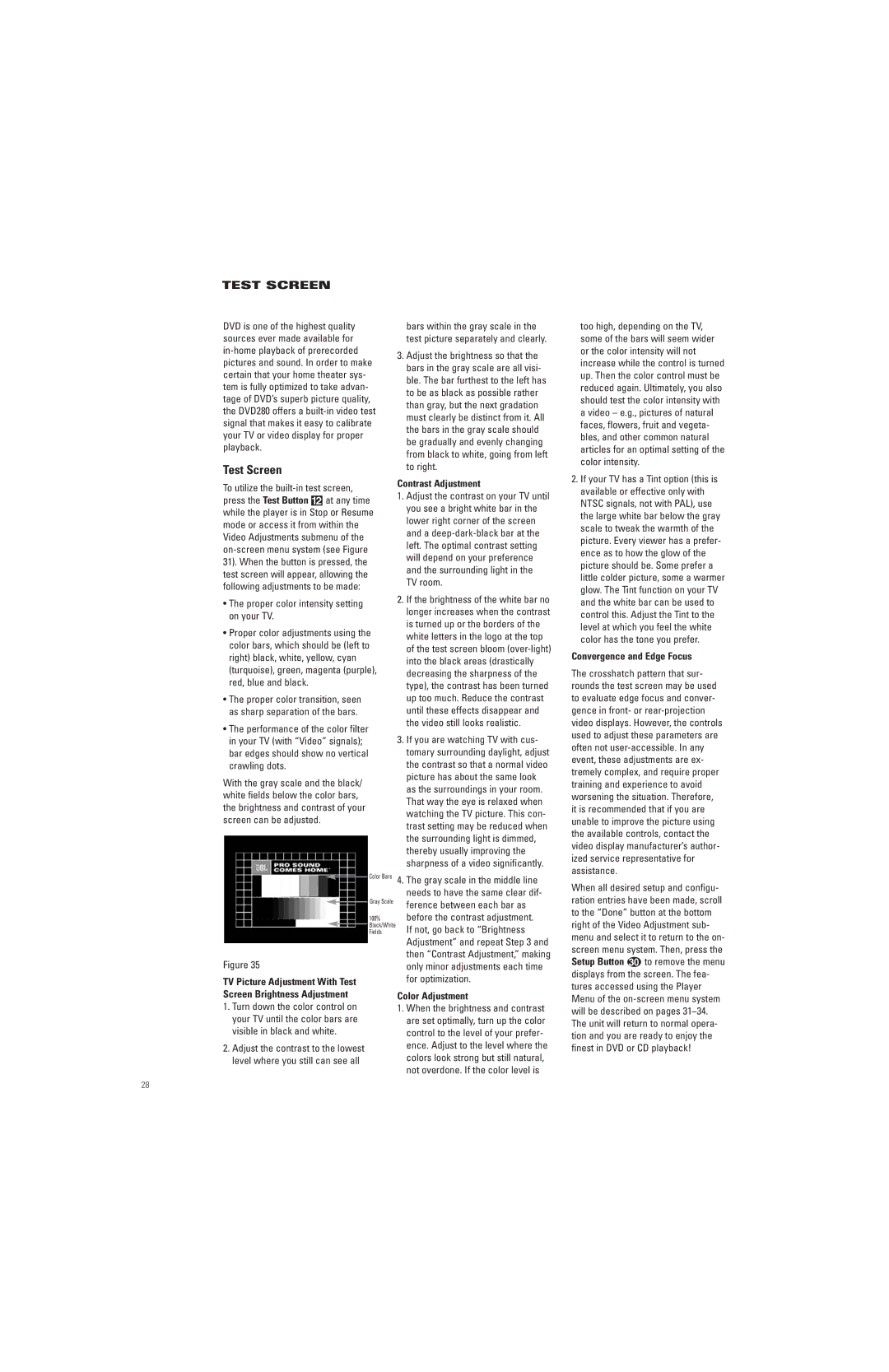
TEST SCREEN
DVD is one of the highest quality sources ever made available for
Test Screen
To utilize the
•The proper color intensity setting on your TV.
•Proper color adjustments using the color bars, which should be (left to right) black, white, yellow, cyan (turquoise), green, magenta (purple), red, blue and black.
•The proper color transition, seen as sharp separation of the bars.
•The performance of the color filter in your TV (with “Video” signals); bar edges should show no vertical crawling dots.
With the gray scale and the black/ white fields below the color bars, the brightness and contrast of your screen can be adjusted.
Color Bars
Gray Scale
100%
Black/White Fields
Figure 35
TV Picture Adjustment With Test Screen Brightness Adjustment
bars within the gray scale in the test picture separately and clearly.
3.Adjust the brightness so that the bars in the gray scale are all visi- ble. The bar furthest to the left has to be as black as possible rather than gray, but the next gradation must clearly be distinct from it. All the bars in the gray scale should be gradually and evenly changing from black to white, going from left to right.
Contrast Adjustment
1.Adjust the contrast on your TV until you see a bright white bar in the lower right corner of the screen and a
2.If the brightness of the white bar no longer increases when the contrast is turned up or the borders of the white letters in the logo at the top of the test screen bloom
3.If you are watching TV with cus- tomary surrounding daylight, adjust the contrast so that a normal video picture has about the same look as the surroundings in your room. That way the eye is relaxed when watching the TV picture. This con- trast setting may be reduced when the surrounding light is dimmed, thereby usually improving the sharpness of a video significantly.
4.The gray scale in the middle line needs to have the same clear dif- ference between each bar as before the contrast adjustment. If not, go back to “Brightness Adjustment” and repeat Step 3 and then “Contrast Adjustment,” making only minor adjustments each time for optimization.
Color Adjustment
too high, depending on the TV, some of the bars will seem wider or the color intensity will not increase while the control is turned up. Then the color control must be reduced again. Ultimately, you also should test the color intensity with a video – e.g., pictures of natural faces, flowers, fruit and vegeta- bles, and other common natural articles for an optimal setting of the color intensity.
2.If your TV has a Tint option (this is available or effective only with NTSC signals, not with PAL), use the large white bar below the gray scale to tweak the warmth of the picture. Every viewer has a prefer- ence as to how the glow of the picture should be. Some prefer a little colder picture, some a warmer glow. The Tint function on your TV and the white bar can be used to control this. Adjust the Tint to the level at which you feel the white color has the tone you prefer.
Convergence and Edge Focus
The crosshatch pattern that sur- rounds the test screen may be used to evaluate edge focus and conver- gence in front- or
When all desired setup and configu- ration entries have been made, scroll to the “Done” button at the bottom right of the Video Adjustment sub- menu and select it to return to the on- screen menu system. Then, press the
Setup Button to remove the menu displays from the screen. The fea- tures accessed using the Player Menu of the
1. | Turn down the color control on | 1. When the brightness and contrast |
| your TV until the color bars are | are set optimally, turn up the color |
| visible in black and white. | control to the level of your prefer- |
2. | Adjust the contrast to the lowest | ence. Adjust to the level where the |
| level where you still can see all | colors look strong but still natural, |
|
| not overdone. If the color level is |
will be described on pages
28
